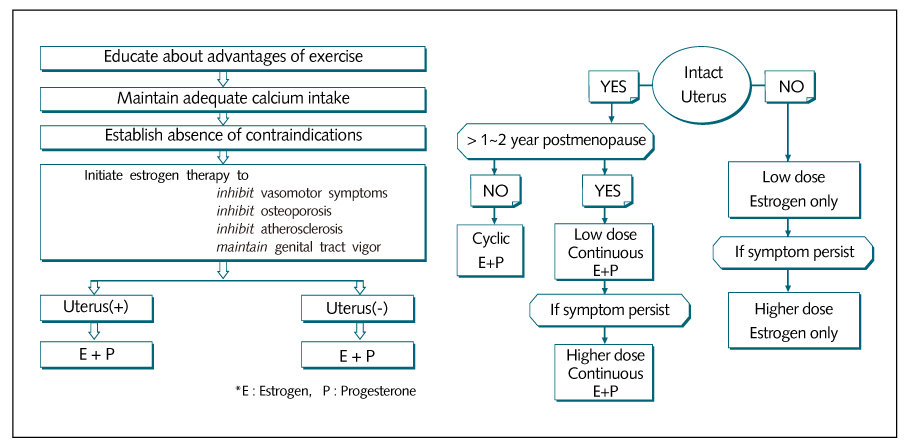J Korean Med Assoc.
2003 Feb;46(2):141-146. 10.5124/jkma.2003.46.2.141.
Management Guide of Perimenopausal Women
- Affiliations
-
- 1Department of Obstetrics & Gynecology, Pusan National University, College of Medical & Hospital, Korea. msyoon@hyowon.pusan.ac.kr
- KMID: 2065103
- DOI: http://doi.org/10.5124/jkma.2003.46.2.141
Abstract
- Menopause and hormone replacement therapy (HRT) are important issues today for women. Estrogens improve climacteric complaints and substantially reduce osteoporosis and cardiovascular disease. Rational clinical practice during the years of climacteric transition requires counselling on the risks and benefits of hormone replacement therapy and proper management of HRT users. Recently, significant findings from two clinical trials have been published in The Journal of the American Medical Association regarding postmenopausal women's use of oral conjugated equine estrogens and oral medroxyprogesterone acetate. This article reports principal results for the trial of combined estrogen and progestin in women with a uterus. The trial was stopped early based on health risks that exceeded health benefits over an average follow-up of 5.2 years. But, we advised Women who for a number of years have been on the combined estrogen/progestin therapy studied here should not panic, but discuss their individual situation with their physician. As for individual women, a decision about hormone use should take into account a woman's individual risk for specific conditions that may be harmed or benefited by hormone use. With respect to women on short-term use of combination hormone therapy for relief of menopausal symptoms, We note that although such use was not the focus of this study, it may be reasonable for women to continue use for this purpose, since the benefits are likely to outweigh the risks.
MeSH Terms
-
American Medical Association
Cardiovascular Diseases
Climacteric
Estrogens
Estrogens, Conjugated (USP)
Female
Follow-Up Studies
Hormone Replacement Therapy
Humans
Insurance Benefits
Medroxyprogesterone Acetate
Menopause
Osteoporosis
Panic
Risk Assessment
Uterus
Estrogens
Estrogens, Conjugated (USP)
Medroxyprogesterone Acetate
Figure
Reference
-
1. Kronnenberg F, Bamard RM. Modulation of menopausal hot flushes by ambient temperature. J Therm Biol. 1992. 17:43.2. Utian WH. The fate of the untreated menopause. Obstet Gynecol Clin North Am. 1987. 14:1–11.
Article3. Whitehead M, Godfree V. Hormone replacement therapy. 1980. New York: Churchill Livingstone;111.4. Lobo RA. Treatment of the postmenopausal women. 1999. 2nd ed. Baltimore: Lippincott Williams Wilkins;95.5. Stevenson JC, Crook D, Godsland IF, Less B, Whitehead MI. Oral versus transdermal hormone replacement therapy. Int J Fertil Menopausal Stud. 1994. 38:Suppl 1. 30–35.6. Swartz DP. Hormone replacement therapy. 1992. Baltimore: Williams Wilkins;171.7. Lupulescu A. Estrogen and cancer risk: a review. Exp Clin Endocrinol. 1993. 101(4):204–214.8. Speroff L, Glass RH, Kase NG. Clinical gynecologic endocrinology and infertility. 1999. 6th ed. Baltimore: Lippincott Wiliams Wilkins;643.9. Studd J. The management of the menopause. 1998. The Parthenon Publishing Group;271.10. Marsh MS, Crook D, Lees B, Worthington M, Ellerington M, Stevenson JC, et al. The effects of oral desogestrel and estradiol continuous combined hormone replacement therapy on serum lipids and body composition in postmenopausal women. Basic Life Sci. 1993. 60:219–220.
Article11. Guidelines for Counseling Postmenopausal Women about Preventive Hormone Therapy. Ann Int Med. 1992. 117:1038.12. Managing the Menopause. A Practical Guide to HRT. 1991. Novo Nordisk Phamaceutical Ltd;36.
- Full Text Links
- Actions
-
Cited
- CITED
-
- Close
- Share
- Similar articles
-
- Menopause Knowledge, Attitude, Symptom and Management among Midlife Employed Women
- Use of Combined Oral Contraceptives in Perimenopausal Women
- Levonorgestrel-Releasing Intrauterine System Use in Perimenopausal Women
- Menopausal Knowledge and Management in Peri-menopausal Women
- Effect of Ca Supplementation on Serum Ca Level and Psychological Conditions in Perimenopausal Women


